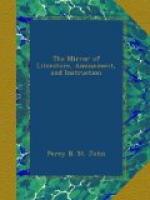The second hallowed relic is at Wheston a small and pleasant village, which is situated on an eminence that forms one side of Monksdale, and which at this place is known by the name of Peter-dale. A short distance from hence is Tideswell, about four miles from Eyam.[5] “Wheston,” observes Mr. Rhodes, “though consisting of a few houses only, is a picturesque little place: the trees which are mingled with the cottages, are so abundant, and everywhere so finely foliaged, that the place altogether, particularly when seen at a short distance, appears more like a copse or wood than a village.” The position of the Wheston cross favours the conclusion already made as to the purposes for which this kind of emblem was originally set up in England. It stands in the village, near the road-side. The upper part of the cross resembles in some of its ornaments the mullion-work of a Gothic window: the shaft is unadorned, and more modern. One side represents the infant Saviour in the arms of his mother: over their heads is a faint indication of a star, emblematic of the ray that directed the wise men of the East to the birthplace of Jesus. The reverse of the cross exhibits the crucifixion of Christ, whose birth and death it has apparently been the design of the sculptor to commemorate in the erection of this symbol of his faith. Similar structures are by no means uncommon by the road-sides throughout France, and to this day the peasantry may be seen bending before them; while the drivers of carriages on the most frequented roads are not unmindful of an act of passing homage to the time-worn emblem.
[5] From King John, the Eyam estate descended to the Stafford family, on whom it was bestowed in consideration of certain military services, and on the express condition “that a lamp should be kept perpetually burning before the altar of St. Helen, in the parish-church of Eyam.” The lamp has long since ceased to burn, and the estate has passed into other hands: it now constitutes a part of the immense property of his Grace the Duke of Devonshire.
Several crosses have been found in this part of Derbyshire, but only a few have escaped the dilapidations of age; the others have been, we had almost said sacrilegiously, destroyed as objects of no value. Mr. Rhodes tells us that “in one place the shaft of a cross, originally of no mean workmanship, has been converted into a gate-post; at another, one has been scooped and hollowed out, and made into a blacksmith’s trough. I have seen one, which is richly sculptured on the three remaining sides, with figures and a variety of ornaments, all well executed, that was long applied to this humble purpose.” The Cut shows that a portion of the cross at Wheston has been broken off; Mr. Rhodes saw the fragment as a common piece of stone, built and cemented into an adjoining wall; and he judiciously adds, “where so little interest has been felt in the preservation of these relics,




